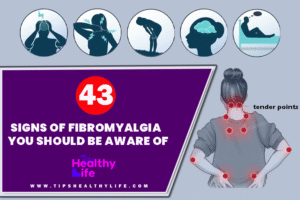Fibromyalgia is one of those mysterious conditions that is often diagnosed only after ruling out many others. This long and frustrating process can leave patients feeling unheard, exhausted, and desperate for answers. For many, it takes months — or even years — before they finally receive a diagnosis.
Once fibromyalgia is confirmed, most are told there’s no “real cure.” Doctors often prescribe painkillers, antidepressants, or sleeping pills to help manage the symptoms. But deep down, people living with fibromyalgia know the truth: it’s not just about managing pain — it’s about reclaiming your life.
Understanding the Symptoms of Fibromyalgia
Fibromyalgia is not just about physical pain. It’s a complex condition that affects your muscles, nerves, and even your emotions. The main symptoms include:
-
Widespread muscle pain and tenderness
-
Chronic fatigue
-
Poor, non-restorative sleep
-
Brain fog or trouble concentrating
-
Emotional sensitivity or anxiety
The severity of these symptoms varies from person to person. Some days you may feel fine, while on others, even small tasks feel impossible.
To make things more complicated, fibromyalgia often appears alongside other health issues — a mix that can make everyday life even harder.
Six Common Conditions Linked to Fibromyalgia
1. Migraines and Chronic Headaches
Migraines are among the most common and painful symptoms reported by people with fibromyalgia. These aren’t ordinary headaches — they’re often intense, throbbing, and can last for hours or even days.
Researchers believe that changes in brain chemicals such as serotonin and norepinephrine may amplify how pain is perceived in the brain. This heightened sensitivity makes migraines more severe and frequent among fibromyalgia patients.
2. Irritable Bowel Syndrome (IBS)
It’s not uncommon for people with fibromyalgia to also suffer from digestive issues. IBS causes stomach pain, bloating, cramping, diarrhea, or constipation — sometimes alternating between both.
Experts suggest that fibromyalgia may affect the autonomic nervous system, disrupting normal digestion and bowel movements. Managing stress, eating a balanced diet, and avoiding trigger foods can help ease discomfort.
3. Autoimmune Conditions
While fibromyalgia itself is not considered an autoimmune disease, it often coexists with autoimmune disorders such as rheumatoid arthritis or lupus.
In these cases, the immune system mistakenly attacks the body’s own tissues, increasing inflammation and worsening pain. Recognizing and treating these underlying conditions is essential for improving overall well-being.
4. Restless Legs Syndrome (RLS)
Many people with fibromyalgia experience a strange, uncomfortable sensation in their legs at night — an irresistible urge to move them. This condition, known as Restless Legs Syndrome, disrupts sleep and contributes to fatigue.
Sleep problems like insomnia or sleep apnea can also appear, leaving the body trapped in a painful cycle of exhaustion and stress.
5. Depression and Emotional Struggles
Up to 90% of fibromyalgia patients experience some form of depression during their lifetime. The ongoing pain, lack of energy, and social isolation can take a toll on mental health.
Scientists believe that fibromyalgia and depression share similar brain chemistry imbalances — especially in the way the body regulates mood and pain perception.
Seeking emotional support, therapy, and connecting with others who understand your journey can make a huge difference.
6. Weight Gain and Obesity
Fatigue and chronic pain can make it difficult to stay active, leading to gradual weight gain. Studies show that people with fibromyalgia are more likely to be overweight or obese than those without the condition.
Extra weight can worsen inflammation, joint pressure, and pain levels. That’s why gentle activities — such as stretching, yoga, or walking — are highly recommended for fibromyalgia management.
Possible Causes of Fibromyalgia
There isn’t one single cause of fibromyalgia. Instead, it often develops from a mix of physical, emotional, and genetic factors, such as:
-
Physical trauma (like an accident or surgery)
-
Emotional stress or trauma
-
Viral infections
-
Autoimmune disorders
-
Family history of fibromyalgia or chronic pain
Doctors typically diagnose fibromyalgia when symptoms persist for more than three months and when specific “tender points” across the body respond painfully to pressure.
A Natural Approach to Healing Fibromyalgia
While traditional medicine focuses on symptom management, many people find additional relief through natural and holistic methods.
Here are some gentle, effective ways to help your body heal:
🌸 1. Prioritize Restorative Sleep
Good sleep is essential. Create a peaceful bedtime routine: limit screen time, take a warm bath, or practice relaxation breathing before bed.
🍃 2. Eat for Energy and Balance
A diet rich in vegetables, lean proteins, omega-3 fats, and whole grains can reduce inflammation and boost energy. Try to avoid processed foods, sugar, and caffeine, which can worsen fatigue and pain.
💧 3. Stay Hydrated
Chronic dehydration can increase muscle pain. Drink plenty of water throughout the day — especially if you take medications that cause dryness.
🧘 4. Gentle Movement
Low-impact exercises like swimming, yoga, or stretching improve flexibility and circulation without overstraining the muscles. Even 10 minutes a day can help.
💆 5. Manage Stress
Meditation, mindfulness, or even journaling can reduce the stress hormones that make pain worse. Emotional calm is key to physical healing.
🌞 6. Natural Supplements
Some people find relief from magnesium, vitamin D, or herbal remedies such as turmeric and ashwagandha — but always consult your doctor before adding supplements.
Living with Fibromyalgia: Hope and Healing
Fibromyalgia may be a lifelong condition, but it does not define who you are. Many people find new strength and resilience after learning to listen to their bodies and make mindful changes.
The journey toward healing is personal — and sometimes slow — but it’s real. Each small step, from taking care of your diet to finding emotional support, brings you closer to peace and comfort.
The truth is, no one told you that you could still live fully with fibromyalgia. But you can. And your healing begins when you believe that your body, no matter how fragile, still holds the power to restore itself.
Source: Adapted and rewritten from The Hearty Soul (100% unique for MAFIBRO.com)




